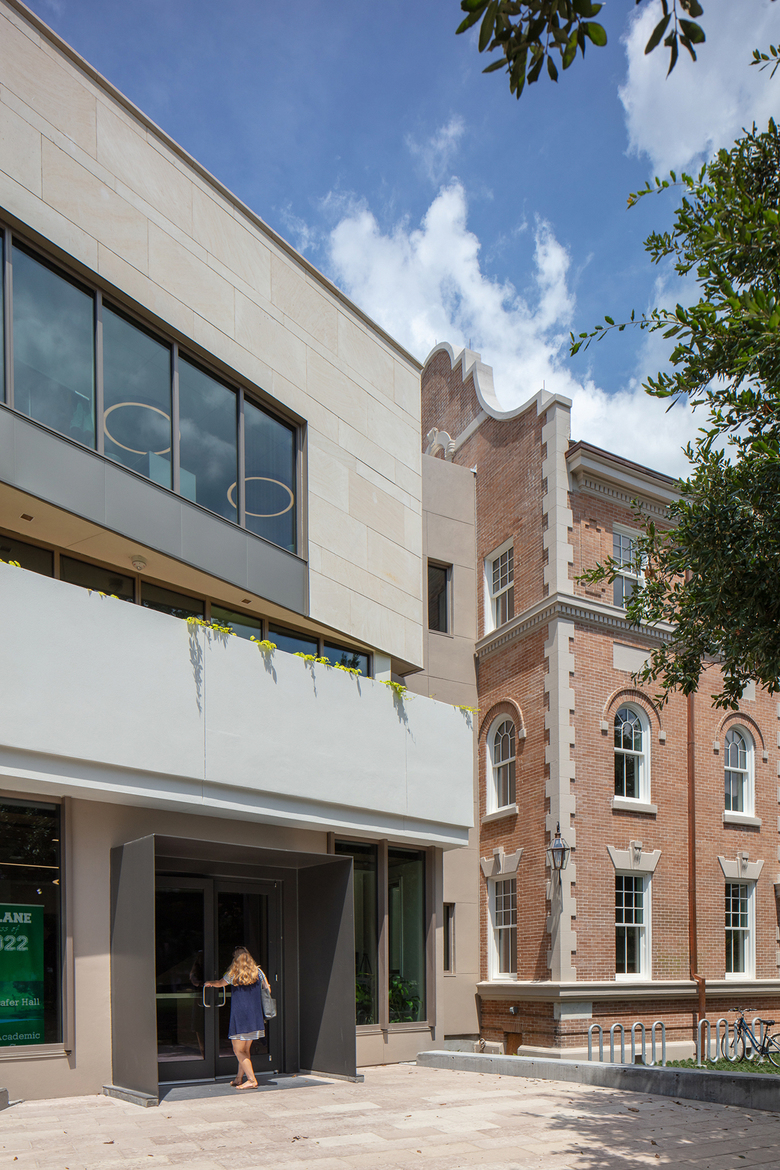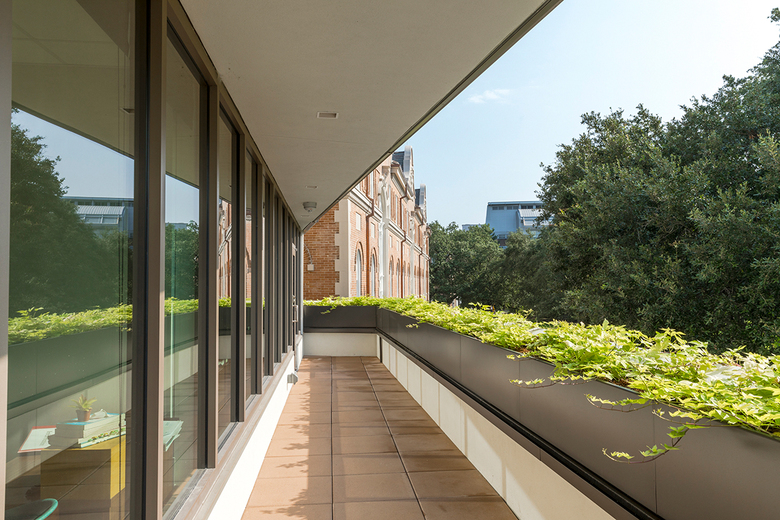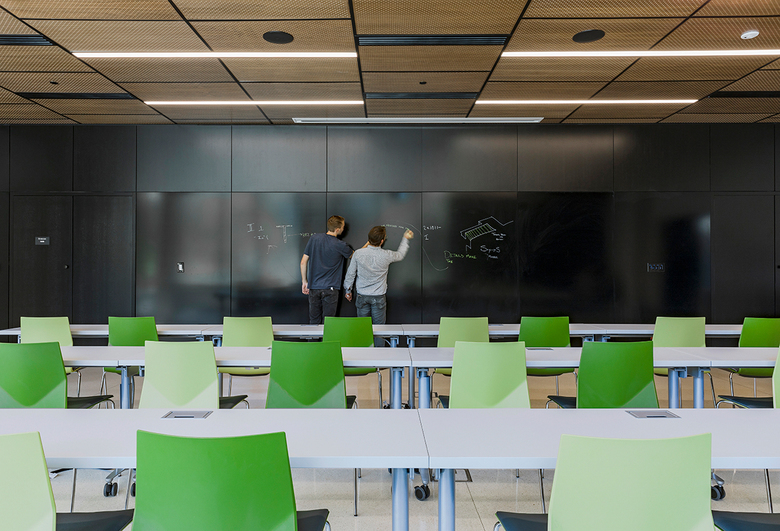U.S. Building of the Week
Mussafer Hall
studioWTA
1. April 2019
Photo: Neil Alexander
The southwest corner of the Johnston Quad on the Uptown campus of Tulane University is anchored by a 100-year-old oak tree with a huge canopy that provides some much needed shade. The addition to a building about the same age as the tree on the west side of the quadrangle is angled toward the tree and positioned to protect its root system. studioWTA answered some questions about their addition and renovation of Mussafer Hall.
Location: New Orleans, Louisiana, USA
Client: Tulane University
Architect: studioWTA
Design Director: Wayne Troyer FAIA
Partner-in-Charge: Julie Babin AIA
Project Team: Nicholas Musser, Nancy Bowden Stewart, Toni DiMaggio, Ray Croft, Laura McAllister, Trent Gauthier, John Philip Mouton, Ross Karsen
Landscape: Spackman Mossop Michaels
Structural + Civil Engineering: Shrenk Endom & Flanagan
MEP + Fire Protection: GVA Engineering
LEED: GCE Services
Contractor: Trimark Constructors
Building Area: 23,000 square feet
Photo: Neil Alexander
What were the circumstances of receiving the commission for this project?The project was won by studioWTA as the result of responding to an invited RFP (Request for Proposals) released by Tulane University, following a master plan study. Mussafer Hall is the second new construction building studioWTA has designed on Tulane’s campus (see also Wall Residential College), and the firm’s twelfth project for the School.
Photo: Neil Alexander
Please provide an overview of the project.Musaffer Hall combines the adaptive reuse of a 1902 Dutch Renaissance-style brick structure, originally constructed as the University’s first dormitory, with a 7,600-sf modern addition. The combined 23,000-sf academic building serves as the home of the university’s new Center for Student Success, which for the first time brings together Tulane’s Academic Advising, Success Coaching and Career Services teams under one roof centralizing services for students on the main academic quad.
Photo: Sara Essex Bradley
What are the main ideas and inspirations influencing the design of the building?Juxtaposition of old and new was the primary concept, with the flexible and dynamic addition being designed to accentuate the form, material, and details of the more structured Dutch-style building, which was previously overlooked and under appreciated. The addition’s dynamic form responds to a majestic 100-year-old live oak tree, as careful planning was required to avoid damage of the tree’s extensive root system.
Photo: Neil Alexander
How does the design respond to the unique qualities of the site?Nestled between two existing historic structures, a road, and a 100-year-old live oak tree, the 7,600-sf addition was largely shaped by its small footprint and unique context. Mussafer Hall’s triangular footprint is respectfully set back from the historic building and angled away from the tree to protect its roots and canopy. studioWTA’s inspiring modern design navigates the space with a series of shifting cantilevered volumes clad in stucco, limestone, and glass. The materials suggest a sense of permanence appropriate for a prominent university and echo the brick, stone, and cement used in the adjacent structure. The recessed second-floor storefront deepens the expression of the cantilever above, which partially shades a large roof terrace designed to take full advantage of the New Orleans climate.
During the course of the project, the City of New Orleans adopted stringent stormwater management requirements which were embraced, as opposed to being viewed as a burden. The design team strove to make the stormwater management strategy a visible feature of the building. In lieu of simply burying a cistern below ground studioWTA designed a large, deep rain garden that contains grasses and a native iris species and also duals as a seating wall at the main entry.
Photo: Sara Essex Bradley
How did the project change between the initial design stage and the completion of the building?The project’s scope, size and budget fluctuated over the course of the design, requiring careful consideration over many iterations in-order remain faithful to the strong initial design concept. At one point in the project, the building was a four story structure.
The University’s initial master plan suggested wrapping and concealing the historic building with the new addition due to the location of an existing central transformer. Working closely with the University and studioWTA’s consulting electrical engineer, a plan was developed to relocate the transformer and re-feed several buildings that were being served. Although an extensive reworking of the system, this allowed the footprint of the new addition to be directly adjacent to the existing building instead of in front of it, honoring the historic structure and enabling it to maintain its presence and identity on campus.
Photo: Sara Essex Bradley
Was the project influenced by any trends in energy-conservation, construction, or design?In addition to sustainable material selections and systems, careful attention was given to passive sustainability measures which required no additional energy. These measure include key design moves such as creating a deep shading cantilever over the second floor storefront glazing, and the inclusion of custom designed large scale plantation shutters at the inside of the first floor glazing, which allowing for many levels of user operability in a multifunctional space. However, perhaps the most responsible sustainable decision was maintaining the original 1902 building. Working closely with a structural engineer, the team preserved as much of the existing wood framing from the original early 1900s structure as possible. Every wood joist was visually observed and tagged for salvage if rot or termite damage was not too extensive. The team also carefully restored all the exterior masonry and decorative elements to assure the building lasts another 100+ years. Mussafer Hall earned LEED Gold certification thanks to its preservation efforts, dedication to passive sustainable measures, and the thoughtful integration of modern systems to improve building performance.
Photo: Sara Essex Bradley
What products or materials have contributed to the success of the completed building?Utilization of a three-hour-rated horizontal sliding fire door assembly (Won-Door) enables one of the building’s required means of egress to remain open at the ground level. It was important to the Design Team that the main stair be open and welcoming upon entry into the building so the team sought an equivalency appeal which was granted by the State Fire Marshal.
A matte black marker board (Clarus) surrounded by ebony wood panels provides a magnetic writing surface in the flexible use room that gives functionality to the room during lectures, while also remaining ‘stealth’ when the room is used for alternate events such as Career Fairs, registration and training. The discrete marker board provides a sophisticated solution for a multi-functional room.
Email interview conducted by John Hill.












